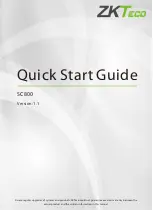
112
en | Troubleshooting transponders, points, receivers, and alert units
Security Escort
2017.08 | V2.18.1.0 | DOC
Training Manual
Robert Bosch (SEA) Pte Ltd
time while testing the alarm location response, using one of the testing methods above.
For example if alarms are being pulled towards a particular receiver, lower its sensitivity
in 10% increments and retest. If the area can be corrected using this method, verify the
surrounding areas to make sure they have not been adversely affected.
It is generally
better if the correction is done in small steps while verifying the adjacent areas, rather
than trying to correct the entire error in one step
.
–
Starting with version 2.03 and higher of the Security Escort software, there are five
different location algorithms that can be selected on an individual receiver basis in the
Transponder Database
. “Classic” (original Security Escort algorithm), “Linear”, “Low“
pull, “Medium” pull and “Strong” pull. By default, when a receiver is set for outside or
tunnel, it will use the “Linear” algorithm and all other receivers will use the “Low” pull
algorithm. The receiver that hears the alarm transmission the strongest will determine the
algorithm used for this alarm. Changing the
Transponder Database
algorithm setting for a
receiver only affects the location when the alarm is close to this receiver and it hears the
alarm the strongest. Change the
Transponder Database
algorithm setting for a receiver
and test in its area, using one of the testing methods above. The stronger the pull the
more the alarm will be pulled towards the receiver, with “Linear” having no extra pull.
Verify the surrounding areas to make sure they have not been adversely affected.
–
Starting with version 2.03 and higher of the Security Escort software, the five different
location algorithms can individually limit how close other receivers must be to the level of
the receiver hearing the alarm the best, before they will be included in the alarm.
“Classic” (original Security Escort algorithm), “Linear”, “Low” pull, “Medium” pull and
“Strong” pull each have a separate setting. By adjusting this setting you can control if
distant receivers with low receive levels will be considered in the alarm calculation.
–
Starting with version 2.03 and higher of the Security Escort software, you can add
“Virtual” receivers in the
Transponder Database
. A “Virtual” receiver is added at one of
the 64 points allowed per transponder. However, there is no physical hardware used. The
“Virtual” receiver is intended to compensate in cases where there is a receiver imbalance.
For example if a building with a dense population of receivers is adjacent to a fence with
few receivers and an alarm occurs between them; the alarm location may pull towards the
building. The “Virtual” receiver references to other physical receivers that must be on the
same transponder. Only if both of the referenced receivers receive an alarm transmission,
then the “Virtual” receiver will be added to the alarm as if was a physical receiver that
heard the alarm at the average receive level of the two reference receivers.
The “Virtual” receiver’s location and sensitivity may be adjusted the same as a physical
receiver. After a “Virtual” receiver is added, verify the surrounding areas to make sure
they have not been adversely affected.
In no event should a “Virtual” receiver be utilized
as a cost savings measure to avoid the installation of an actual receiver
.
7.6
System preferences dialog
The
System preferences
dialog under the
Setup
menu contains a number of settings that
govern the behavior of the Security Escort System.
















































